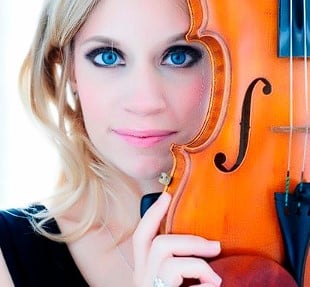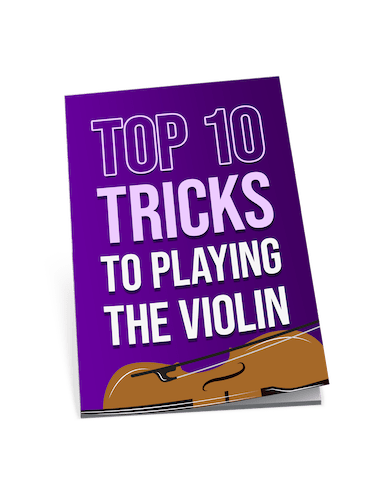Best
CARBON FIBER
BOW
Marquise Escher UNMATCHED PRECISION & CLARITY
-
Overall:
The signature Escher frog for refined response -
Best Feature: A burnt Xebony composite
umber lizard grip -
TedScore™: 9/10
Best
VIOLIN BOW FOR BEGINNERS
-
Overall: Tailor-made to meet the needs of a developing musician
-
Best Feature: Forgiving center-tip balance
-
TedScore™: 9.2/10
Best
WOODEN BOW
Pernambuco Bow
No.982 HIGH-QUALITY WOODEN BOW
-
Overall: German-made Paulus ebony frog
with a Parisian eye -
Best Feature: Three-part button
-
TedScore™:
8/10
The violin bow might seem like a simple stick with strings, but it’s really a complex marvel, much like the violin itself.
Every part of it works harmoniously to create the rich, expressive tones you love.
So, what are the parts of a violin bow? The violin parts are a handful to remember; how many more additional details of violin bow parts?
Well, this article is specifically written to deal with that dilemma.
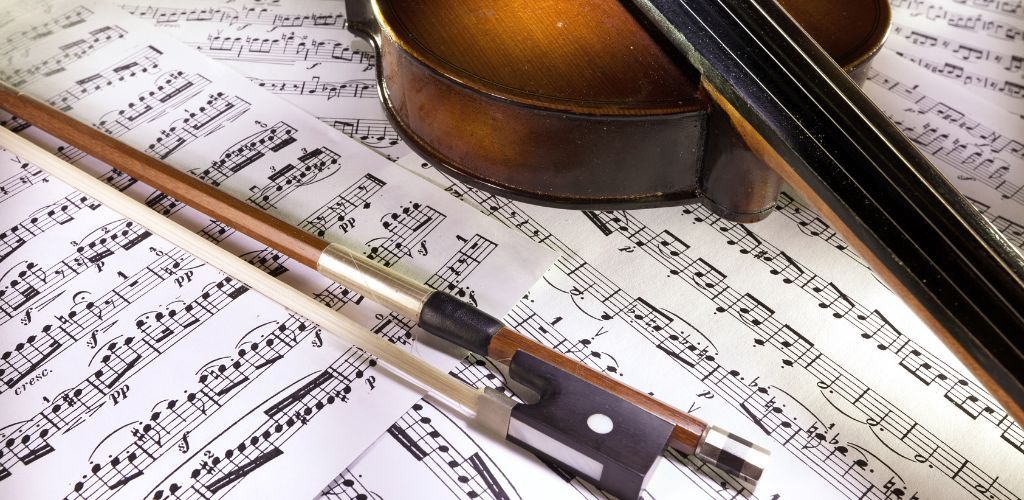
When you hold a violin bow, you’re having a musical craftsmanship!
Each component, from the violin bow tip and violin bow hair to the violin bow frog, plays a crucial role in bringing your music to life during a performance.
Understanding these parts of the violin bow can enhance your skills, whether you’re a seasoned musician or picking up a bow for the first time. Knowing how to utilize each section ensures you can draw out every ounce of emotion from your violin strings.
Main Components of a
Violin Bow
A violin bow is an elegant tool consisting of several key components. Each part plays a crucial role in drawing out the beautiful sounds of a violin.
Stick

The stick is the main shaft of the bow and is typically made of wood or carbon fiber (thus the name carbon fiber bows!).
Your bow’s stick should be straight and solid yet flexible.
Hair

Horse hair is commonly used for bow hair because it effectively grips violin strings (but there are bows out there with synthetic bow hair, as well!).
Regular grooming ensures a smooth, clean, and desired sound.
Frog
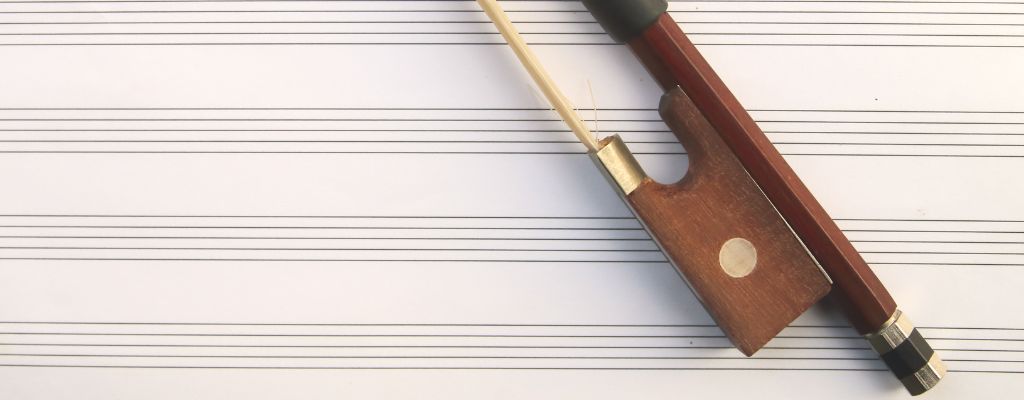
The frog (this is different from the frog you’re thinking of right now!) is where your fingers rest and is usually crafted from ebony.
Adjustments here can affect the tension of the hair. The two key areas where the bow hair and the bow stick meet are the tip and the frog, both of which are crucial for the functionality and performance of the violin bow.
The Throat
The throat is the narrow, curved part of the bow stick that connects the frog to the rest of the stick. This section is typically crafted from a single piece of wood, meticulously shaped to provide a smooth, even surface for the bow hair to glide across.
The throat plays a pivotal role in the bow’s overall performance, as it helps distribute the tension of the bow hair evenly. This ensures a comfortable, balanced feel in the hand, making it easier to produce those beautiful, resonant tones.
Whether you’re using a traditional wooden bow or a modern carbon fiber bow, the throat’s design is essential for maintaining the bow’s integrity and functionality.
The Ferrule
The ferrule is a small but mighty component of the violin bow, located at the bottom of the frog where the bow hair meets the stick.
This ring, often made of durable materials like nickel or silver, serves a crucial purpose: it protects the bow hair from wear and tear and prevents it from coming into direct contact with the stick. By ensuring a smooth, even surface, the ferrule helps maintain the bow’s performance and longevity.
It’s a testament to the detailed craftsmanship that goes into making a high-quality violin bow, ensuring that every part works harmoniously to produce the best sound possible.
Top Tip
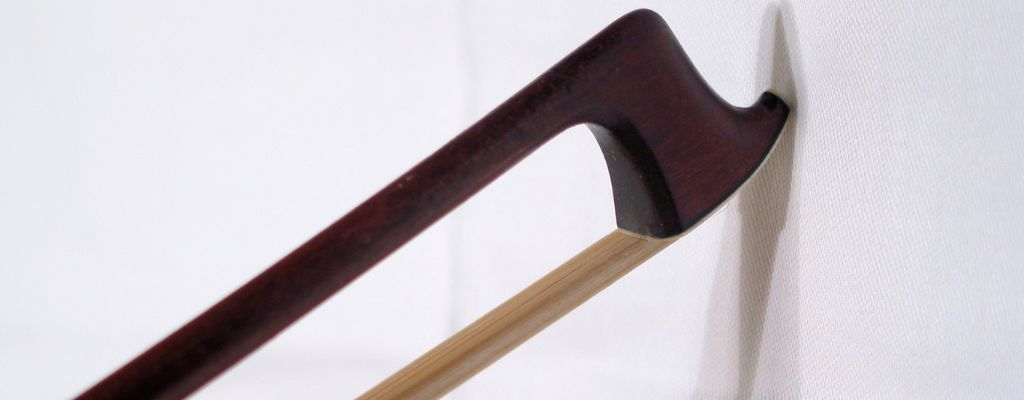
The tip, or the point of the bow, often includes a tip plate made of ivory, bone, or more modern materials like plastic.
It adds balance and protects the delicate end of the stick.
The Screw (Button)
The screw, also known as the button, is a small yet essential component located at the end of the bow opposite the tip.
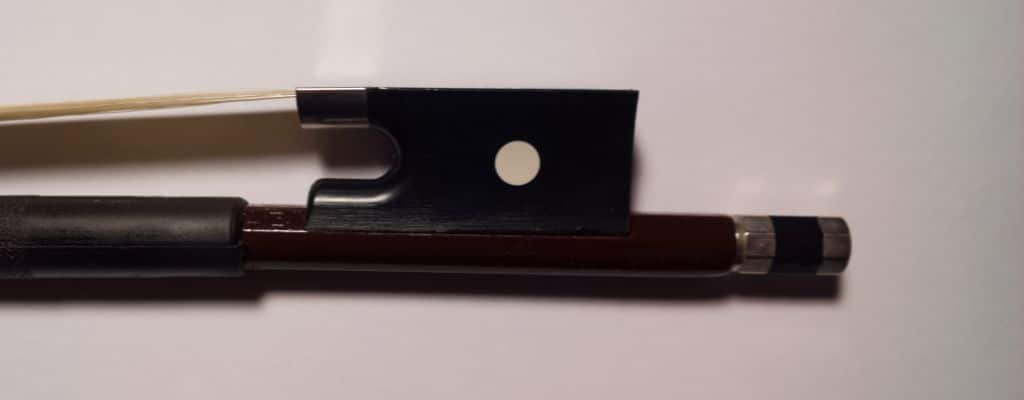
Its primary function is to regulate the tension of the bow hair, allowing you to adjust the bow’s performance to suit your playing style. By turning the screw clockwise, you can tighten the bow hair, enhancing its responsiveness.
Conversely, turning it counter-clockwise will loosen the hair, which can be beneficial after a playing session to preserve the bow’s elasticity.
Proper adjustment of the screw is crucial for achieving optimal performance from your bow, ensuring that it responds perfectly to your every command.
Bow Mechanics and Functionality
The violin bow might seem simple, but its mechanics are essential for producing the sound quality you adore.
With just the right touch and playing style, it’s the key to bringing your violin to life.

Tension and Release
Your bow’s tension can be adjusted by turning the screw at the end. Tightening the screw increases tension on the bow hair, which can enhance responsiveness.
Conversely, loosen the tension after a playing session to help preserve the bow’s elasticity and extend its life.
Maintaining proper and correct tension is crucial for that perfect tone!
Weight and Balance
The bow’s balance point greatly influences its handling. You’ll usually find this sweet spot approximately 1/3 of the way from the frog or the end you hold.
A bow that’s balanced just right feels like an extension of your hand, making it easier to play with precision.
Playing Techniques
Your bow is an artist’s brush on the canvas of strings, each stroke contributing to the overall masterpiece!
The middle of the bow gives you the best control for various violin techniques. With a balanced bow in your hand, playing becomes second nature, allowing you to focus on the texture and color of the music you’re creating.
Remember, your bow is a partner in your musical journey. Keep it well-adjusted, and it’ll be sure to respond to every command you give!
Grip and Comfort Features
When you hold a violin and its bow, the feel in your hand is crucial to your comfort and performance.
Let’s take a peek at the specific features that ensure your hand stays cozy while you play.

Thumb Leather
Thumb leather is the protective layer that shelters the bow stick from oils and sweat from your thumb.
Usually crafted from cow or goat hide, this leather wraps around the stick right where your thumb rests, just beneath the frog.
Make sure it’s smooth, as any roughness can distract from your practice and playing experience.
Grip Padding
The grip is often padded with soft material to cushion your fingers, making it easier to hold for long periods.
This padding can vary from a superficial foam layer underneath the wrapping to elaborate designs that contour to your fingers.
Its goal? To prevent fatigue, your focus remains on the music.
Winding Materials
Winding is made of various materials, such as whalebone (a traditional term for a type of plastic today), silver wire, or even gold for luxurious models.
It provides a counterbalance to the bow tip and influences the feel of the grip.
Winding also helps protect the stick from wear and tear when your hand makes contact. Each material offers a different texture; you can choose what best suits your hand.
Materials and Craftsmanship
You’re about to discover the secrets behind making a violin bow!
The interplay of materials and craftsmanship defines a bow’s quality and performance.
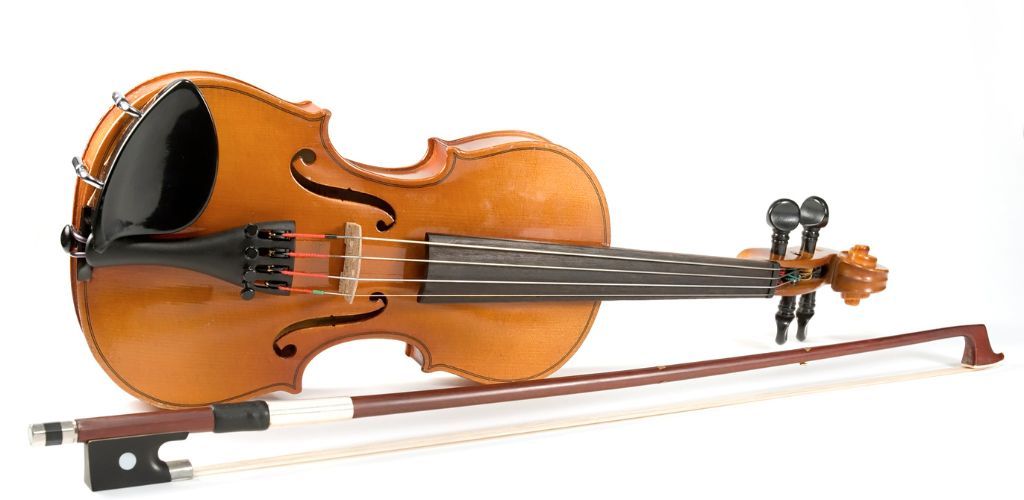
Traditional Woods
Pernambuco is the gold standard for bow-making, renowned for its resilience and ability to produce rich, powerful sounds.
Brazilwood, a more accessible cousin, offers a softer tone and quiet sounds and is frequently used in student bows.
Synthetic Alternatives
Modern bows can feature a synthetic material like carbon fiber, which provides durability and weather resistance.
These materials mimic the flexibility of wood, ensuring your bow is always performance-ready.
Metal Components
Expert violin makers often use metals like nickel, silver, and gold for fittings and mountings.
Silver mounts are commonly found in professional bows and gold, representing your bow’s elegance and value.
Decorative Elements
The eye of the frog isn’t just decorative; it signifies the bow’s craftsmanship.
Ebony wood is often chosen for the frog and button, offering a sleek appearance and superior strength.
Maintenance and Care
Taking care of your violin bow is essential to keep it in tip-top shape, ensuring many musical moments.
Regular maintenance is your bow’s best buddy and will save you trips to the luthier!
Rehairing
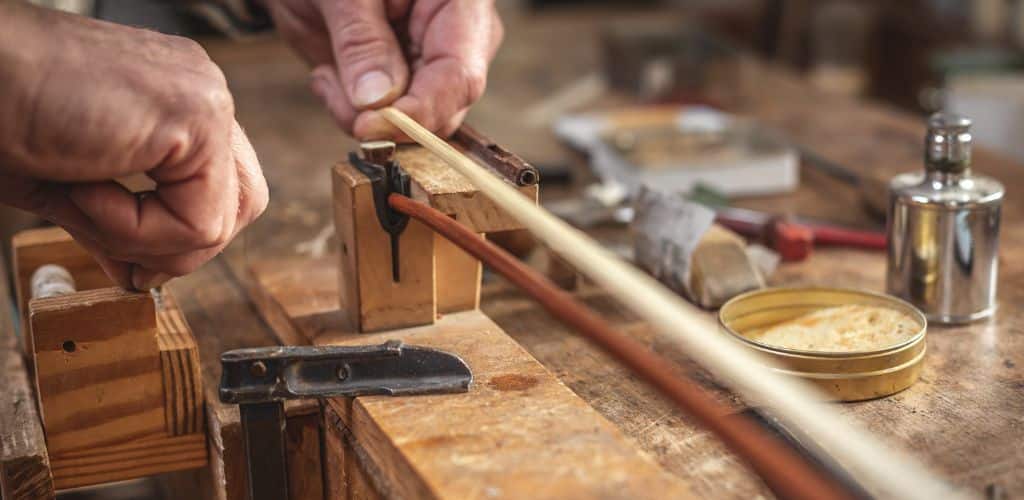
Your bow hair will naturally wear out with play, so rehairing is like a spa day for your bow!
Depending on how often you play, aim to get a re-hair every 6-12 months. When the hair looks frayed or doesn’t hold rosin well, it’s time to see a professional.
Cleaning
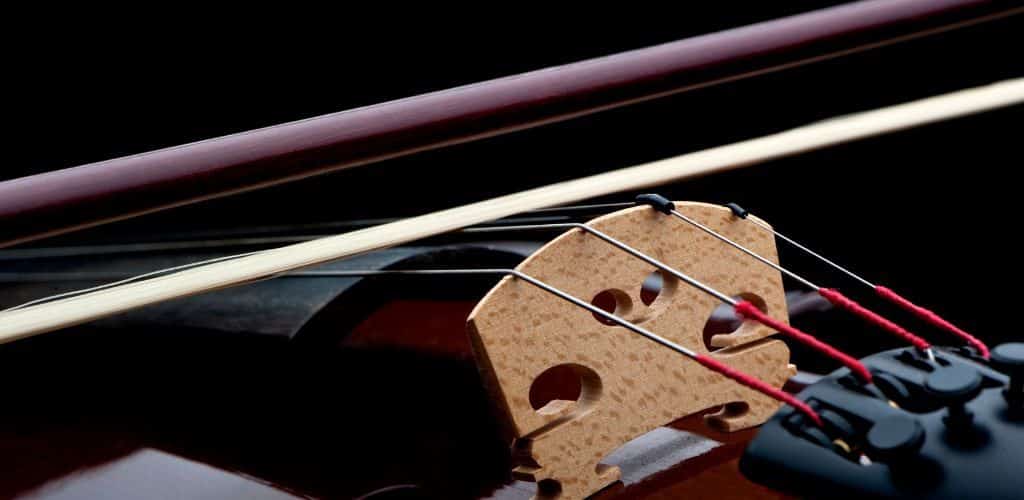
A clean bow sings better!
After each use, gently wipe down the bow with a soft, dry cloth to remove excess rosin dust.
For the stick, use a separate cloth slightly dampened with alcohol, not touching the hair.
Always loosen the bow hair before putting it away; this takes necessary tension off and prevents warping.
To keep your bow in pristine playing condition, store it in a case at room temperature, away from heat and humidity.
Violin Bows I Love!
Codabow Marquise CS Escher Violin Bow
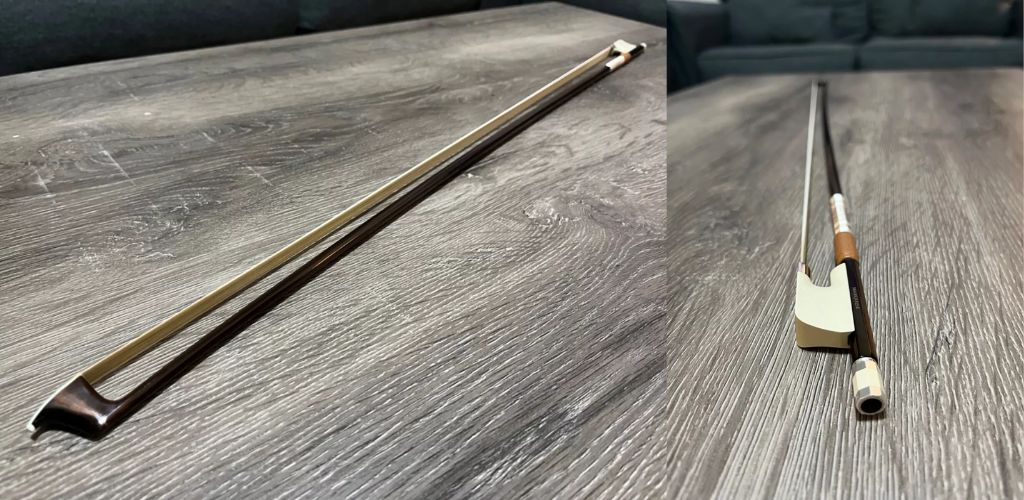
The CodaBow Marquise GS Escher Violin Bow stands out with its exceptional craftsmanship and advanced acoustic capabilities, embodying a perfect fusion of artistry and engineering.
As a professional violinist, I wholeheartedly recommend this bow for its superior handling and responsiveness, which will undoubtedly elevate the performance of any serious musician.
Codabow Marquise CS Escher Violin Bow
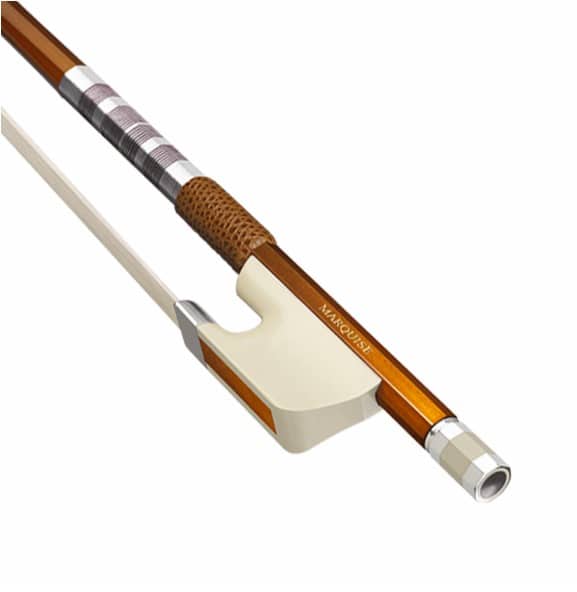
FEATURES:
- The signature Escher frog
- A burnt umber lizard grip
-Unidirectional carbon fibre with natural acoustic core
- Can Achieve A Wonderful Organic Sound
- Produced in an environmentally sustainable manner
- Stronger and more durable than natural ebony
- It's not the cheapest bow on this list...
When you click ‘Check Price’, you’ll see there are loads of great places to buy this item. Our personal favorite is Sweetwater for the US, and Thomann and Gear4Music for the UK & Europe.
They are the largest music retailers, with excellent customer service, competitive prices, really fast shipping, and the longest guarantees.
The professional musician who wrote this article combined many things,
from the product build, manufacturer’s reputation through to feedback
from other users, to create our famous TedScore™.
Franz Sandner Pernambuco Bow No.982
The Franz Sandner Pernambuco Bow No.982 exudes a classic charm with its high-quality wood and meticulous construction. It offers a warm and rich tone that lovers of traditional wooden bows will appreciate.
I confidently recommend this bow to my peers who seek the timeless feel and sound that only a genuine Pernambuco bow can provide.
Franz Sandner Pernambuco Bow No.982

FEATURES:
- German-made Paulus ebony frog with a Parisian eye
- Three-part button
- Silver winding
- Available in 4/4 size
- Produces a warm and rich tone
- Made from high-quality Pernambuco wood
- Provides a secure and comfortable grip
- Limited availability compared to other wood bows
When you click ‘Check Price’, you’ll see there are loads of great places to buy this item. Our personal favorite is Sweetwater for the US, and Thomann and Gear4Music for the UK & Europe.
They are the largest music retailers, with excellent customer service, competitive prices, really fast shipping, and the longest guarantees.
The professional musician who wrote this article combined many things,
from the product build, manufacturer’s reputation through to feedback
from other users, to create our famous TedScore™.
CodaBow Prodigy Student Violin Bow
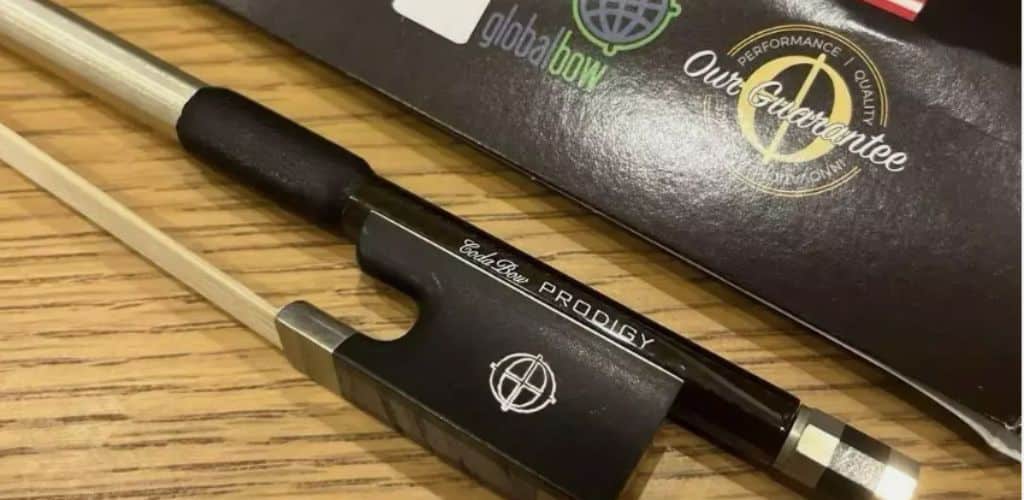
The CodaBow Prodigy Student Violin Bow – 4/4 Size offers a remarkable blend of durability and playability. It is an excellent choice for aspiring violinists seeking a professional-grade bow at a student-friendly price.
I consider this the right bow for my students because of its consistent performance and ability to enhance their technique and sound as they progress.
CodaBow Prodigy Student Violin Bow

FEATURES: Designed specifically to help students develop proper playing technique
OTHER INFO: High-wear components are precision-made using industry-leading composite materials to ensure a lifetime of worry-free play
- Firm action to facilitate a deep string connection that students will find inspiring
- Ultra-strong and eco-friendly Xebony frog that is stronger and more durable than natural ebony
- No Cons at all!
When you click ‘Check Price’, you’ll see there are loads of great places to buy this item. Our personal favorite is Sweetwater for the US, and Thomann and Gear4Music for the UK & Europe.
They are the largest music retailers, with excellent customer service, competitive prices, really fast shipping, and the longest guarantees.
The professional musician who wrote this article combined many things,
from the product build, manufacturer’s reputation through to feedback
from other users, to create our famous TedScore™.
Parts of a Violin Bow:
Things to Bear in Mind!
Your violin bow’s got character, just like you!
STICK: your bow’s backbone is often crafted from Pernambuco or carbon fiber. It bends and rebounds with your every move, making sweet music.
HAIR: traditionally, from the horse’s tail, it’s tensioned by the frog, the part you tighten or loosen with a twist of the screw.
TIP: points your music in the right direction, gracefully finishing the stick’s journey.
FROG: (no rabbits here!)The one responsible for the tension of your bowstring.
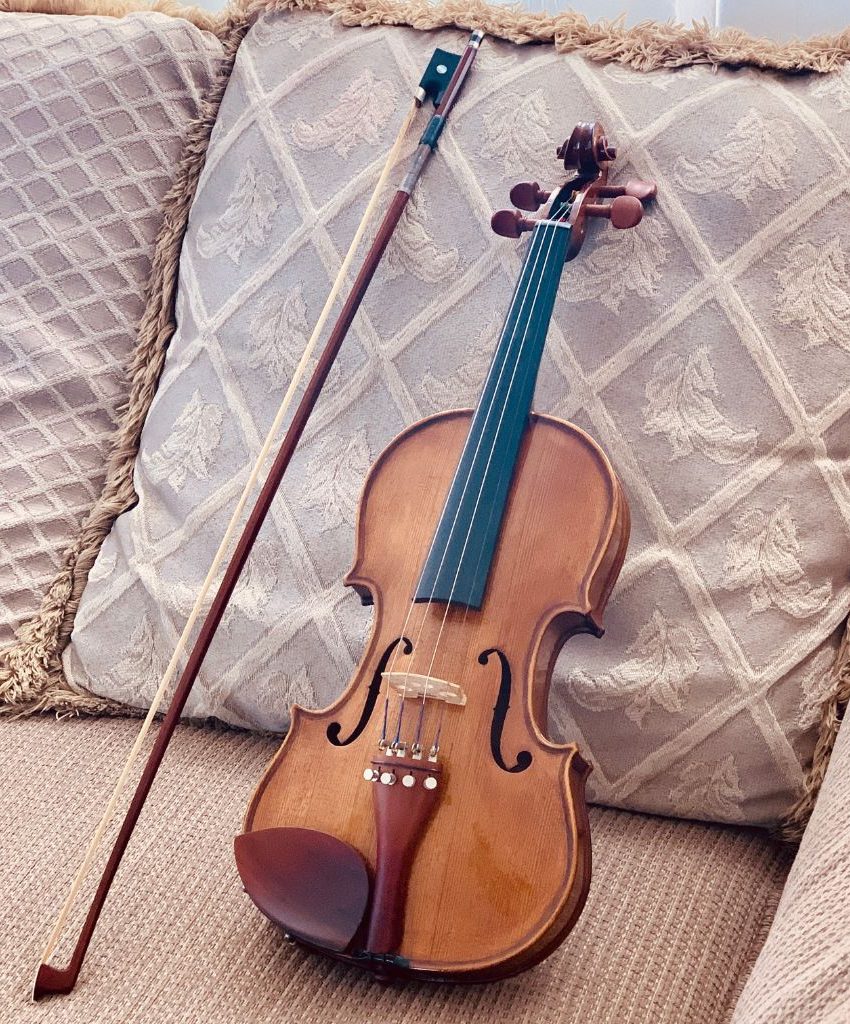
In this mini-universe of music-making, every part has its role. You keep it all working in harmony with a sprinkle of rosin and a touch of care.
Remember, your bow is like a trusty sidekick in your symphonic adventures!
So play away, knowing the secrets of your bow! Keep your bow’s parts in mind; they’ll help you achieve optimal performance!
Hold on a minute! There’s something else…
Now that you know the parts of the violin bow, it will be easier for you to determine which one is perfect for you! Read the following article for the ultimate guide to choosing the best violin bow for you!
FAQ's
The parts of the bow consist of several key components: the stick, which is traditionally made from Pernambuco wood or fiberglass, provides the necessary flexibility and balance; and the hair, typically made of horsehair, which is stretched between the tip and the frog, the mechanism that allows for tension adjustment. Additionally, the grip and winding near the frog offer the player comfort and control, while the tip, often adorned with a decorative plate, protects the head of the bow.
The handle of a violin bow is commonly called the “frog.” It is the part where the violinist holds the bow and controls the tension and stretch of the hair and the bow’s articulation and dynamics during play.
The nut on a violin bow is another term for the frog end, which is the part at the end of the bow that the player holds. The frog includes the mechanism that tightens or loosens the horsehair on the bow, which is crucial for playing dynamics and maintaining the proper tension.
The base of a violin bow, where the player grips the bow and controls the tension of the hair, is known as the violin bow frog. This essential part of the bow facilitates the adjustment of the horsehair tightness and provides balance and stability during a performance.




